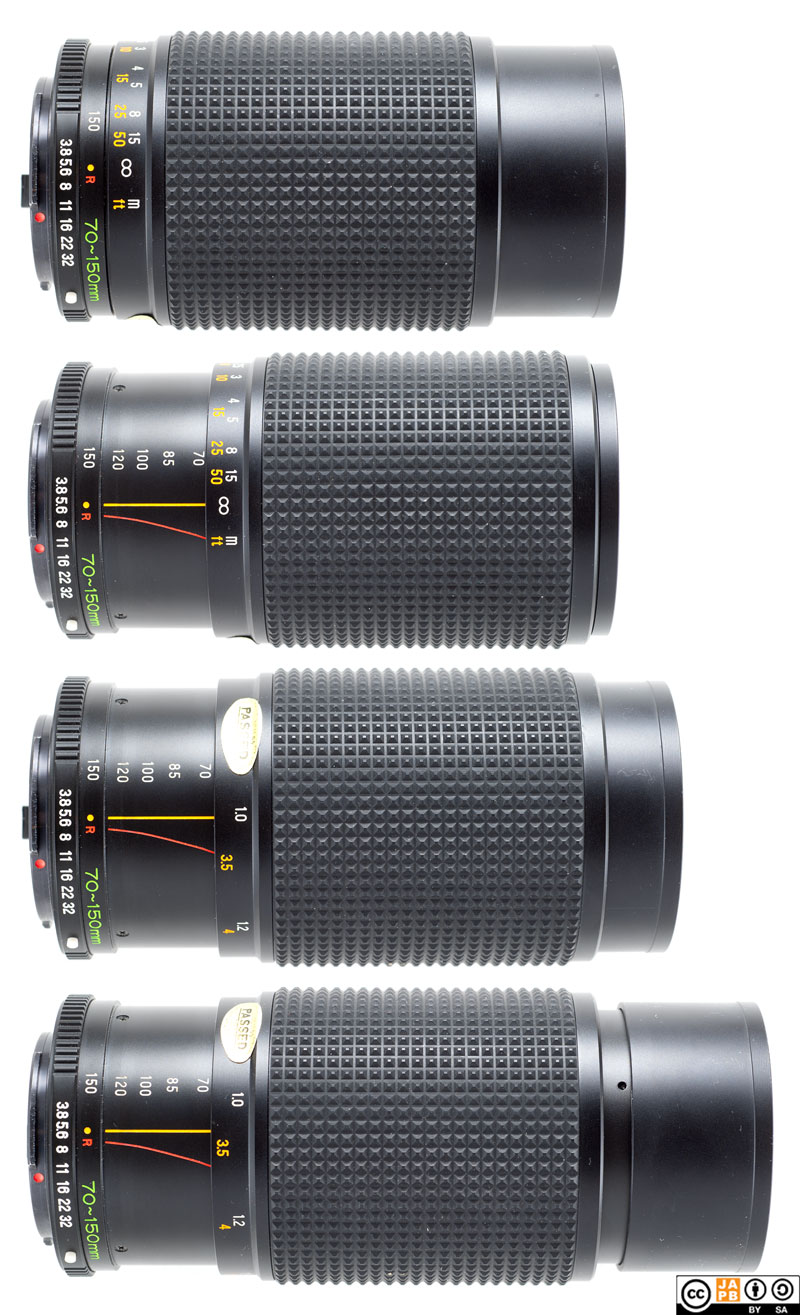Pekka Buttler, 06/2025

Specifications
The table below summarizes the lens’ key specifications (measurements based on pictured sample):
| Brand: | Mamiya-Sekor | Lens name | Zoom E 80~200mm 1:3.8 |
| Focal length(s)1 | 70–150 mm | Angle-of-view2 | 34,3°–16,4° |
| Maximum Aperture | f/3.8 | In Production | 1981-1984 |
| Lens mount | Mamiya Z/E | Subfamily (if applicable) | –– |
| Length3 | 119,3 mm | Diameter4 | 65,0 mm |
| Filter ring diameter | 52 mm | Weight | 503 grams |
| Lens element count | 12 | Lens group count | 9 |
| Aperture blades (S/R/C)5 | 6 S | Focus throw | 220 ° |
| Minimum focusing distance | 102 cm @70mm 99 cm @150mm | Maximum magnification | 1:10,4 @70mm 1:4,9 @150mm |
| Has manual aperture ring | NO | Has Manual focus ring | YES |
| Aperture mechanism type | electronic/mechanic 6 | Aperture click stops 7 | 3.8•5.6•8•11•16•22•32 |
Further notes:
• In 1980 Mamiya introduced the Z line of cameras and altogether 16 lenses.
• 10 of those lenses were regular primes in the range of 28 to 300 mm, one short macro lens and altogether 5 zooms.
• Of those zooms, one can be characterised as a wide-angle zoom (28–50 mm), two can be described as standard zooms (35–70 and 35–105), and two more were typical tele zooms (70–150 and 80–200).
• Judging by their element counts, two of those zooms were constructed using a more elaborate/ambitious design. One of these was the 35–105/3.5–4.3 (15 elements in 13 groups) and the other was the 80–200/3.8 (14 elements in 10 groups).
• This lens is a relatively compact, comparatively bright tele zoom.
• The lens is a one-ring zoom, meaning that you adjust focal length by pushing or pulling on a ring and that you rotate to adjust focus.
• To zoom in (towards a narrower field of view), you pull the ring backward. The lens’ zooming action is internal, meaning that the lens does not change shape when zooming.
• When rotating the focusing ring from infinity towards minimum focusing distance, the lens becomes a 11,6 millimetres longer.
• The filter threads rotate when focusing.
• The lens is not parfocal – neither at infinity nor MFD.
• It has a decent focus throw and a not entirely unattractive minimum focal length.
• As a quirk that was typical for the Mamiya Z system, the lens does have an aperture ring, but that ring has no function on the lens itself (Mamiya Z lenses aperture rings communicated the chosen aperture to the camera, which in turn did the closing down). This has implications on adaptability (read more below).

• Mamiya-Sekor E 70-150/3.8 zoomed to 150 mm, focused to infinity.
• Mamiya-Sekor E 70-150/3.8 zoomed to 70 mm, focused to infinity.
• Mamiya-Sekor E 70-150/3.8 zoomed to 70 mm, focused to MFD.
• Mamiya-Sekor E 70-150/3.8 zoomed to 70 mm, focused to MFD, integrated hood extended.
Versions
There was only ever one version of the Mamiya-Sekor E 70-150 mm f/3.8
History of Mamiya Z/E lenses
Please see the JAPB article on all (7) Mamiya SLR lens mounts to understand the role of the Mamiya Z/E mount.
Adapting
n.B! The following applies to all Mamiya Z/E mount lenses.
This lens cannot be used natively on any current SLR or dSLRs. To use it in its native environment, you will need a Mamiya Z/E-mount film body – a ZE, ZE-2, ZE-X or ZM. While the Mamiya Z/E system remained in production for only 4 years (and was not a mega-hit), these bodies are relatively easy to find.
While the lens sports electronic contacts, these are not needed to facilitate critical functionality. However, as the aperture ring of Mamiya Z/E lenses is a dummy ring (it does not manipulate the lens’ aperture in any way – it instead communicates the aperture to the camera body, which in turn manipulates the lens’ aperture lever), adjusting aperture is a function that has to be taken care of by the adapter.
Therefore, should you aim to adapt this lens to a mirrorless camera you will need an adapter that facilitates adjusting the lens’ aperture. Luckily, every Mamiya Z/E adapter I’ve seen does offer such a functionality. However, due toMamiya Z/E lenses not being among the most numerously manufactured, special adapters (helicoid adapters, tilt/shift adapter and speed boosters) are currently unavailable.
Using Mamiya Z/E lenses on dSLRs is also possible. However, due to that the, difference in flange focal distances between the Mamiya Z/E lens and the dSLR mount (between +1,5 mm and negative 1 mm) invariably does not allow sufficient space for an adapter that allows aperture modification, these adapters are always adapters with added optics to achieve infinity focus.
Footnotes
- Focal length is (unless stated otherwise) given in absolute terms, and not in Full-frame equivalent. For an understanding of whether the lens is wide/tele, see ‘Angle-of-view’. ↩︎
- Picture angle is given in degrees (based on manufacturers’ specs) and concerns the diagonal picture angle. Rule of thumb:
> 90 ° ==> Ultra-wide-angle
70–90 ° ==> Wide-angle
50–70 ° ==> Moderate wide-angle
40–50 ° ==> ‘Standard’ or ‘normal’ lens
20–40 ° ==> Short tele lens
10-20 ° ==> Tele lens
5-10 ° ==> Long tele lens
< 5 ° ==> Ultra-tele lens ↩︎ - Length is given from the mount flange to the front of lens at infinity. ↩︎
- Diameter excludes protrusions such as rabbit ears or stop-down levers. ↩︎
- S=straight; R=rounded; C=(almost)circular at all apertures. ↩︎
- The lens communicates the selected aperture electronically, but the lens is closed down mechanically. ↩︎
- Numbers equal aperture values on aperture ring; • intermediate click; – no intermediate click. ↩︎